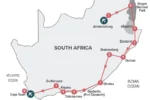The Drakensberg is the main mountain range of Southern Africa. Stretching for more than 1,000 kilometers (600 miles). It crosses most of the country but the UNESCO World Heritage site is in KwaZulu Natal. The Drakensberg is the main watershed of South Africa and is the source of the Orange River.
While there are many mountains in South Africa; KwaZulu-Natal’s 200km long uKhahlamba-Drakensberg escarpment is; by far; the most impressive. With peaks that exceed 3000m forming the backbone of the Maloti-Drakensberg Transfrontier Conservation and Development Area. Nestled between the Kingdom of Lesotho and South Africa. It is a prime South African Eco-tourism destination and a World Heritage Site.
Drakensberg; or simply the Berg; is a dynamic wonderland of river valleys, mountain streams, rugged cliffs, and hiking trails. The stunning scenery attracts thousands of travelers every year. Mainly during the hotter summer months of December to February.
The Berg is divided into the southern, central, and northern regions. The N3 national road between Durban and Johannesburg; is well signposted to access routes for each of these regions.
When to visit and what activities are on offer:
The Drakensberg is a year-round destination. Winter days (May to August) are mild, but it can get very cold at night. Snow in the higher regions is common in June, July, and August. Visit in winter if you’re looking for Rock climbing and ice climbing (June to August). Giant’s Castle, Lotheni, and Sani Pass all offer excellent climbing conditions. Visit in spring/summer (September to March); if you’re looking to enjoy the mountain pools and wildflowers.
There’s no shortage of adventure options in summer (December to February). You can go kayaking, tube riding, horse riding, hiking, mountain climbing, swimming, canyoning, fly fishing and so much more.
For an invigorating bird’s eye view enjoy paragliding, hang gliding, and helicopter or gyrocopter flights.
The Giant’s Cup Trail is a good all round hike. The Cathedral Peak Trail provides experienced hikers with access to this iconic 3 004m peak. The 12km hike to the top of Mont-aux-Sources (3 282m); complete with its 100-rung chain ladder; is a must for the experienced.
Explore the hundreds of caves found here. Many of these cave walls tell the story of the nomadic San people. Who recorded their lives in rock art paintings throughout this area. In fact; there are around 600 rock art sites; with over 35 000 images. Depicting humans, animals, and the complex spiritual life of the San; over a 4000-year period.
The Drakensberg is home to a huge diversity of protected plant and animal species. The Drakensberg is also a Wetlands of International Importance (RAMSAR); for its high altitude wetlands which lie above 2750m. And consequently, for its amazing birdlife.
Golf junkies are catered for too; with a few 9 and 18-hole courses to be played in the area.
Events in Drakensberg
During Easter, the Splashy Fen Music Festival attracts thousands of visitors to the southern Drakensberg. For 4 days of music, art, crafts, food, and drink.
Polar Bear Swim at Dragon’s Peak Dam at Estcourt in June; the Berg & Bush Descent (mountain bike race) in October/November; Sani Stagger Endurance Race up Sani Pass in November.
Underberg and Himeville
Lying in the foothills of the mighty uKhahlamba-Drakensberg, Underberg is a typical rural farm town. Dusty roads, pristine mountain streams, and enormous sandstone backdrops have sculpted the rustic haven that is Underberg.
A convenient base from which to explore the Sani Saunter. This tourism region is demarcated by Loteni in the north; and Bushman’s Nek in the south. It includes Underberg’s neighbor; Himeville; 5km down the road.
Thanks to the Mzimkhulu River, the most popular attraction in this part of South Africa is fly fishing. The Underberg Himeville Trout Fishing Club alone enjoying rights to more than 160km of river and 60 dams.
Fly fishing is closely followed by hiking, then biking and river tubing. Hikers can take on slow, meandering trails if they prefer. The strong and fit will want to try the challenging trek up Rhino Peak. Where you can enjoy magnificent views over neighboring Lesotho. The 35 300-hectare Garden Castle State Forest offers lovely scenic walks and numerous rock art sites in the sandstone caves that are so typical of these mountains.
Nature lovers will enjoy the 104-hectare Himeville Nature Reserve or the Swamp Nature Reserve near Pevensey. Here endemic wildlife and bird species abound. Additionally; the trout fishing allure of the 1 159 hectares of Vergelegen Reserve. And you have a well-rounded day filled with wildlife viewing that ends with a dinner you caught yourself.





















